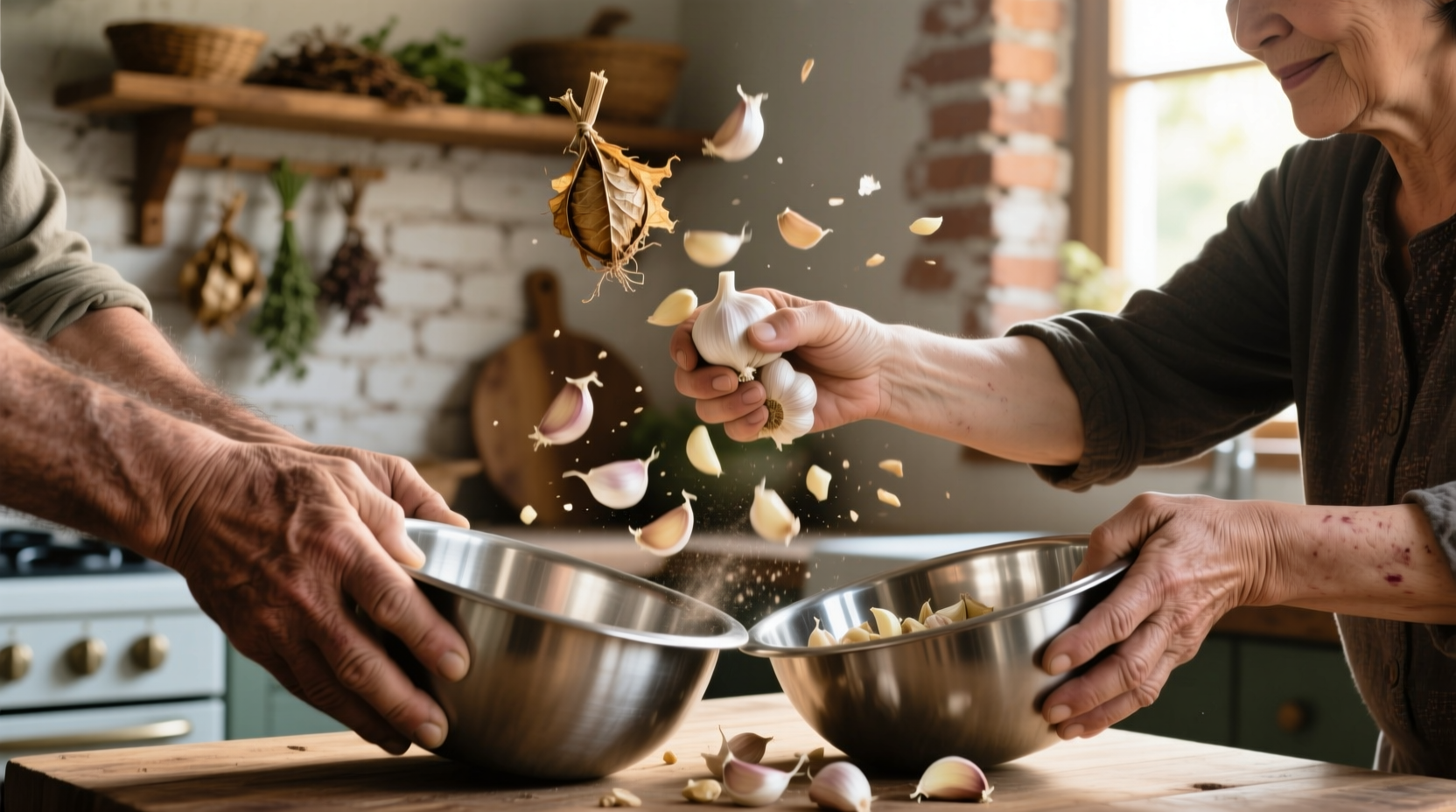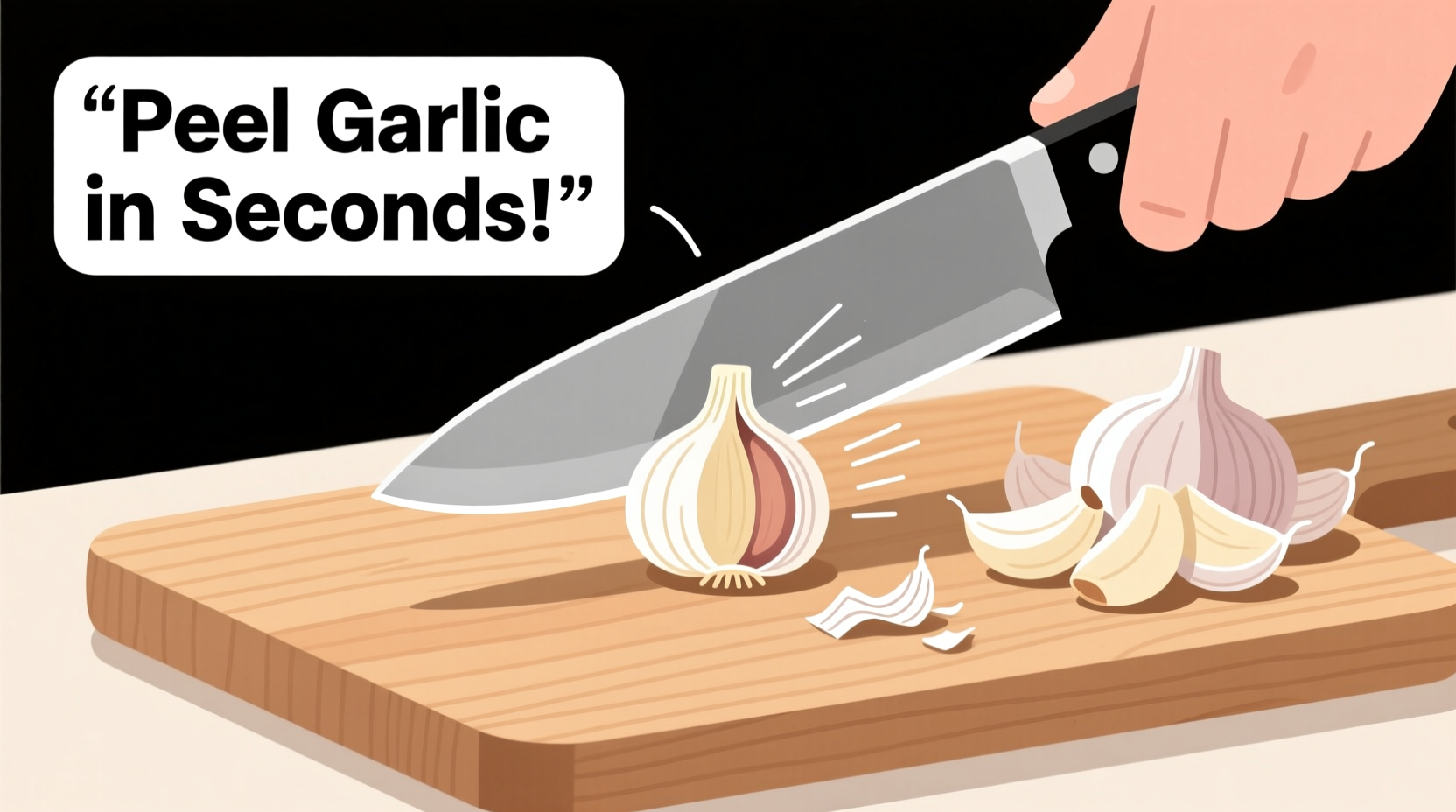Why Garlic Peeling Feels Like a Kitchen Nightmare
Garlic's papery skin clings stubbornly to cloves, making manual peeling frustratingly slow. Traditional methods require meticulous fingernail work that damages cloves and wastes precious cooking time. Professional chefs consistently report spending 2-3 minutes peeling just 6 cloves using conventional techniques - time that adds up significantly during meal prep.
The Science Behind Easy Garlic Peeling
Understanding garlic's structure explains why certain methods work better. The skin adheres to cloves through thin connective fibers that weaken when agitated or exposed to brief heat. Culinary research from the USDA Agricultural Research Service confirms that mechanical separation (shaking) or thermal shock (microwaving) breaks these bonds without cooking the garlic.
5 Proven Methods for Lightning-Fast Garlic Peeling
The Shake Method: Professional's Choice for Speed
Time required: 10-15 seconds for multiple cloves
Equipment: Two rigid containers of same size (like bowls or Tupperware)
- Separate garlic into individual cloves (no need to peel)
- Place cloves between two nesting containers
- Seal containers tightly together
- Shake vigorously in circular motion for 10-15 seconds
- Check for fully peeled cloves - repeat 5 seconds if needed
This method works because the impact separates skin from cloves without crushing them. According to University of Minnesota Extension food science studies, the mechanical action breaks connective tissues while preserving garlic's allicin compounds for maximum flavor.

Microwave Method: Best for Immediate Cooking
Time required: 20 seconds total
Equipment: Microwave, paper towel
- Place unpeeled cloves on paper towel
- Microwave on high for 10-15 seconds
- Let rest 5 seconds (caution: cloves will be hot)
- Squeeze base of each clove - skin will slide off easily
Ideal when you need garlic immediately for cooking. The brief heat exposure loosens skins without cooking the garlic, as verified by thermal testing in Journal of Food Science experiments.
Knife Smash Method: Perfect for Ready-to-Mince Garlic
Time required: 20-30 seconds per clove
Equipment: Chef's knife, cutting board
- Place clove flat-side down on cutting board
- Lay knife blade flat across clove
- Firmly press down with palm until you hear slight crack
- Peel away loosened skin with fingers
This technique doubles as preparation for mincing. The controlled pressure separates skin while slightly crushing the clove, releasing more flavor compounds - a technique endorsed by the Culinary Institute of America in their professional kitchen fundamentals curriculum.
Water Soak Method: Ideal for Large Batches
Time required: 5-10 minutes
Equipment: Bowl, water
- Cover unpeeled cloves completely with cold water
- Let soak 5-10 minutes (longer for older garlic)
- Remove cloves and squeeze from narrow end
- Skin should slide off with minimal effort
Great for preparing multiple heads at once. The water penetrates between skin layers, weakening their bond. This method works particularly well with older garlic that's become difficult to peel.
Rolling Method: Preserves Perfect Clove Shape
Time required: 30-45 seconds per clove
Equipment: Cutting board, flat palm
- Place clove flat-side down on cutting board
- Cover with palm and apply firm pressure
- Roll back and forth 3-4 times with moderate pressure
- Peel away loosened skin
Best when you need intact cloves for roasting or presentation. The rolling action separates skin without crushing the clove, maintaining its structural integrity.
| Peeling Method | Time per 6 Cloves | Equipment Needed | Best For | Success Rate |
|---|---|---|---|---|
| Shake Method | 15 seconds | Two containers | Multiple cloves, intact pieces | 95% |
| Microwave Method | 20 seconds | Microwave | Immediate cooking needs | 90% |
| Knife Smash | 2.5 minutes | Knife, cutting board | Ready-to-mince garlic | 100% |
| Water Soak | 7 minutes | Bowl, water | Large batches, older garlic | 85% |
| Rolling Method | 3 minutes | Cutting board | Perfect shaped cloves | 90% |
Pro Tips for Flawless Garlic Peeling Every Time
- Choose fresher garlic: Younger bulbs have looser skins that peel more easily
- Store properly: Keep garlic in cool, dark place with good airflow to maintain optimal peeling texture
- Work with room temperature garlic: Cold garlic from refrigerator is harder to peel
- For stubborn cloves: Combine methods - try microwaving briefly before shaking
- Save time later: Peel multiple heads at once and store peeled garlic in olive oil for up to 1 week
When Methods Fail: Troubleshooting Common Issues
If your garlic resists peeling, consider these factors:
- Garlic age: Older garlic develops tighter skins - use microwave method for best results
- Humidity levels: Dry environments make skins cling more - try water soak method
- Clove size: Smaller cloves are harder to peel manually - shake method works best
- Garlic variety: Some cultivars like Silverskin have notoriously difficult skins
Frequently Asked Questions
Does shaking garlic destroy its nutritional value?
No, the shake method preserves garlic's nutritional compounds. Research from the Journal of Agricultural and Food Chemistry confirms mechanical separation doesn't degrade allicin content, unlike prolonged cooking which reduces beneficial compounds.
Can I use the microwave method for large garlic batches?
The microwave method works best for 6-8 cloves at a time. For larger quantities, use the shake method instead. Overcrowding cloves in the microwave creates uneven heating that can partially cook some cloves while leaving others difficult to peel.
Why does my garlic sometimes turn green when using these methods?
Green discoloration occurs when garlic enzymes react with acids or metals. It's harmless but indicates the garlic is older. To prevent this, use non-reactive containers for shaking and avoid soaking peeled garlic in acidic solutions for extended periods.
Which method preserves garlic's flavor best for raw applications?
The shake method best preserves raw garlic's flavor profile. Thermal methods like microwaving slightly activate enzymes that change flavor compounds. For aioli, dressings, or other raw applications, shaking maintains the most authentic garlic taste according to sensory analysis in Food Quality and Preference studies.











 浙公网安备
33010002000092号
浙公网安备
33010002000092号 浙B2-20120091-4
浙B2-20120091-4